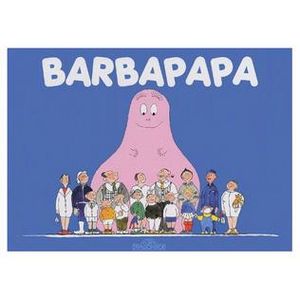Barbapapa facts for kids

Cover of hardbound edition of Barbapapa, ISBN: 2-87881-230-1
|
|
| Authors | Annette Tison and Talus Taylor |
|---|---|
| Language | French |
| Genre | Children's literature |
| Published | 1970 |
| Publisher | L'École des Loisirs |
| OCLC | 225805 |
| 823.91 | |
| LC Class | PZ7.T518 |
Barbapapa is a popular children's book series. It was first published in 1970. The books were created by Annette Tison and Talus Taylor. They were a French-American couple living in Paris, France.
The main character is named Barbapapa. This is also the name of his special kind of creature. The first book was written in French. Later, it was translated into more than 30 languages. The name Barbe à papa means "Daddy's beard" in French. It is also the French word for cotton candy.
Contents
How Barbapapa Began
The Sweet Inspiration
The idea for Barbapapa came by chance in May 1970. This happened in the Luxembourg Garden in Paris. Talus Taylor was walking with Annette Tison. He heard a child asking for something called "Baa baa baa baa".
Since he didn't speak French well, he asked Annette what it meant. She told him the child wanted Barbe à papa, which is cotton candy.
Later, at a restaurant, the couple started drawing. They drew a pink, round character inspired by the candy. When they needed a name, Barbapapa just fit perfectly.
Publishing the First Book
Many publishers in Europe liked the idea. But they did not want to pay for the publishing costs. Then, Frank Fehmers, a Dutch publisher, helped. He set up a way for different companies to work together.
The first Barbapapa books came out in 1970. They were published in French by L'École des Loisirs. Other versions came out in Dutch, British English, and American English.
Meet the Barbapapa Family
The Barbapapa family are the main characters. They are special because they can change their shape into anything they want!
What Barbapapas Look Like
When they are in their normal form, Barbapapas are blob-shaped. They have a clear head and arms, but no legs. Male Barbapapas have a rounder bottom. Female Barbapapas are a bit more slender.
Each Barbapapa can change into any shape. But you can always tell who they are. They keep their faces and their special color.
The Original Barbapapa
Barbapapa himself is a pink, blob-like creature. He looks a bit like a papaya. He grows out of the ground. He tries to fit in with humans.
When he changes shape, he often says, "Clickety Click—Barba Trick!" In the 1970s British TV show, he would say "All Change!"
The Barbapapa Children
After many adventures, Barbapapa meets Barbamama. She is a black, shapely female Barbapapa. Together, they have seven children.
They have four sons:
- Barbabravo is red and loves sports.
- Barbabright is blue and is a scientist.
- Barbazoo is yellow and loves nature.
- Barbabeau is black and furry, and he is a painter.
They also have three daughters:
- Barbalala is green and loves music.
- Barbabelle is purple and cares a lot about her looks.
- Barbalib is orange and is very smart.
Barbapapa on Screen and in Music
Television Shows
A few years after the books, Barbapapa became a TV show. The first cartoon was almost five minutes long. It first aired in 1974. Over 100 episodes were made for the TV series.
In 1999, a new Japanese cartoon came out. It was called Barbapapa Around the World (バーバパパ 世界をまわる, Barbapapa Sekai wo Mawaru). This show followed the family as they traveled to different countries. More than 50 episodes were made.
A brand new animated show started in 2019. It aired in France, Finland, and on Nick Jr. in other places. This show was written by Alice Taylor and Thomas Taylor. Alice is the daughter of the original creators.
Barbapapa Music
The first Barbapapa TV show had a catchy theme song. The words were written by Harrie Geelen. The music was made by Joop Stokkermans.
The Japanese version of the show had a different theme song. A Spanish kids' music group called Parchis even made a song about the Barbapapa characters.
Comic Books
Barbapapa also appeared in comic books. Both the cartoons and comics sometimes share important messages. These messages often talk about caring for the environment.
Barbapapa's Lasting Impact
The Barbapapa cartoon is loved in many countries. It has been translated into many languages. In the United States, it was shown on different TV channels in the 1970s.
The original series is still shown on TV in Italy today. Barbapapa toys and other items are still made every year in Japan.
On May 19, 2015, Google made a special picture for its homepage. This picture, called a Google Doodle, celebrated Barbapapa's 45th anniversary.
The French music group Air was inspired by the Barbapapa show. Their song "Ce matin là" has horn sounds that remind them of the show.
See also
 In Spanish: Barbapapá para niños
In Spanish: Barbapapá para niños

